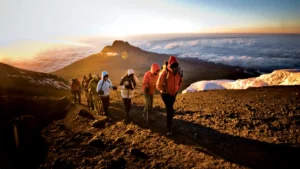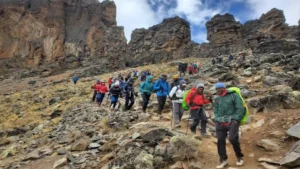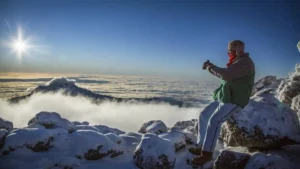We deliver responsible, sustainable tourism
The Best Expert Guide on Kilimanjaro
Home » What is the Best Route to Climb Kilimanjaro
Rating:
Climbing Mount Kilimanjaro is a once-in-a-lifetime adventure—but your chances of reaching the summit largely depend on which route you choose. When determining the best route to climb Kilimanjaro, it’s essential to understand that there are seven established routes to Uhuru Peak, each with unique characteristics, success rates, scenery, and levels of difficulty. Moreover, knowing which path to take is crucial for maximizing your summit success and enjoying Tanzania’s legendary peak.
When evaluating which is the best route to climb Kilimanjaro, consider these key factors: Eight main Kilimanjaro routes climb to the summit of the “roof of Africa”. Those are: Lemosho (Shira route), Machame, Marangu, Rongai, Northern Circuit, Umbwe, Kilema, and Western Breach
| Route | Duration | Approximate Success Rate | Key Features |
|---|---|---|---|
| Northern Circuit | 8–9 days | 95% | Highest summit success, least crowded |
| Lemosho | 7–8 days | 85–90% | Panoramic views, high success |
| Machame | 6–7 days | 85–90% | Most popular, very scenic |
| Rongai | 6–7 days | 70–85% | Drier, quiet, north-side approach |
| Marangu | 5–6 days | 50–65% | Hut accommodation, busiest |
| Shira | 6–7 days | 75–85% | High-altitude start, remote |
| Umbwe | 5–7 days | Low | Steepest, most challenging |
In addition, there are different itineraries available for most routes. For example, there are 6, 7, and 8-day variations for the Lemosho route. Each of those variations offers a slightly different acclimatization profile. While the choice between a shorter and a longer itinerary might seem trivial, the longer itineraries typically offer much higher success rates due to better acclimatization. If you’re looking to embark on a Kilimanjaro climb and are not sure which route and itinerary is right for you, here we will guide you through every route’s unique advantages and disadvantages.

The Northern Circuit consistently ranks as the top choice for several compelling reasons:
Furthermore, this route provides the most comprehensive climbing experience, making it ideal for those prioritizing success over speed.
The Lemosho route stands out as an excellent option for nature enthusiasts:
Additionally, many climbers consider Lemosho the ideal balance of beauty and success rates.
When exploring the best route to climb Kilimanjaro, the Machame route offers several advantages:
Nevertheless, despite the crowds, many choose Machame for its balanced approach and proven track record.
The Rongai route presents unique advantages for specific conditions:
Consequently, for those climbing during challenging weather, Rongai provides reliable conditions and may be the best route to climb Kilimanjaro during certain seasons.
While not always the top choice for success rates, Marangu offers unique benefits:
However, for those prioritizing comfort over camping, this provides the most convenient option, though it’s rarely considered the best route to climb Mount Kilimanjaro for summit success.
The Shira route shares similarities with other premium options:
Therefore, while offering spectacular views, it’s recommended primarily for seasoned mountaineers.
The Umbwe route represents the most difficult option:
Consequently, this route appeals only to very experienced mountaineers seeking maximum difficulty.
When comparing routes to climb Kilimanjaro, success rates clearly indicate optimal choices:
| Route | Typical Itinerary | Success Rate |
|---|---|---|
| Northern Circuit | 9 days | 95% |
| Lemosho | 8 days | 90% |
| Machame | 7 days | 85–90% |
| Rongai | 7 days | 85% |
| Marangu | 6 days | ~65% |
| Umbwe | 6 days | <60% |
Importantly, longer itineraries significantly improve success rates due to better acclimatization, which is crucial when determining the best route to climb Kilimanjaro for your needs.
The main challenge on Mount Kilimanjaro is not the steep slopes or long daily hikes, but the altitude. So, itineraries that offer the best acclimatization profiles might be considered the “easiest”. Perhaps, we can again highlight Lemosho 7-8, Rongai 7, with Machame 7 and Northern Circuit following close.
Lemosho route 7-day itinerary is the most accessible route on Mount Kilimanjaro for several reasons. Beginning at an elevation of 3500 meters, it eliminates the need for ascending to that altitude during the trek. Short initial daily hikes prevent overexertion, so your body can focus on adapting to the altitude. All overnight stays are at 3500 meters or above, also facilitating better acclimatization. Additionally, the route from the Barafu Camp to the summit is the shortest, saving approximately an hour in travel time.
The Northern Circuit offers great acclimatization due to more days spent on the mountain, but it is more suitable for hikers who are prepared for longer treks every day. For beginners, the above-mentioned Lemosho, Rongai and Machame might be easier options with a higher chance of summitting. If you feel that you need extra time for rest and acclimatization, it’s possible to add an extra acclimatization day at any of the camps to your itinerary.
Rongai and Northern Circuit are famous for having the least crowds. The first days of Umbwe will also spoil you with serene landscapes free from large groups of hikers.
A useful tip is to avoid peak seasons – July to September, and January to February. The best time to climb to avoid crowds is just before or after the high seasons – like the first part of March, the beginning of June, or the end of October – when the weather is still good, but there are much fewer climbers on the trails.
Selecting the right option among routes to climb Kilimanjaro depends on your specific priorities:
Furthermore, understanding your priorities helps determine which is the best route to climb Kilimanjaro for your climbing goals.


Regardless of which route you consider the best route to climb Mount Kilimanjaro, timing matters significantly. The ideal months for climbing are January to early March, and June through October, when weather conditions are most favorable and skies are clear. During these periods, all routes to climb Kilimanjaro offer better conditions and higher success rates.
After analyzing all available options, several key conclusions emerge:
Northern Circuit stands out as the premier choice for its exceptional combination of success rate, scenery, and solitude. Moreover, it consistently delivers the highest summit success rates.
Lemosho proves ideal for trekkers seeking stunning views and excellent acclimatization, making it another top contender when determining the best route to climb Mount Kilimanjaro.
Machame represents an excellent balance of popularity, scenery, and accessibility, provided you’re prepared for crowds during peak seasons.
Additionally, all Kilimanjaro routes require thorough preparation, appropriate itinerary length, and realistic assessment of your fitness and altitude tolerance.
Finally, choose the path that best matches your goals, available timeframe, and climbing experience. For most adventurers, the best route to climb Kilimanjaro features sufficient days for proper acclimatization and gradual altitude gain. Ultimately, success depends on selecting a route that safely guides you to Uhuru Peak while providing an unforgettable African mountain experience.
Hiking Kilimanjaro is a leading adventure company specializing in safe, guided climbs to the summit of Mount Kilimanjaro, offering expert guides and unforgettable trekking experiences.